Sennheiser SKM 300, SKM 300 G3 User Manual

SKM 300
Instruction manual

Contents |
|
Contents |
|
Important safety instructions .............................................. |
2 |
The SKM 300 G3 radio microphone family ........................ |
3 |
The frequency bank system ............................................ |
3 |
Areas of application ........................................................... |
4 |
Delivery includes ...................................................................... |
5 |
Product overview ..................................................................... |
6 |
Overview of the SKM 300 G3 radio microphone .......... |
6 |
Overview of the displays .................................................. |
7 |
Putting the radio microphone into operation ................... |
8 |
Inserting the batteries/accupack .................................... |
8 |
Charging the accupack ...................................................... |
9 |
Changing the microphone head ................................... |
10 |
Changing the color-coded protection ring ................. |
11 |
Using the radio microphone ............................................... |
12 |
Switching the radio microphone on/off ..................... |
12 |
Deactivating the lock mode temporarily .................... |
14 |
Muting the audio signal or deactivating |
|
the RF signal ..................................................................... |
14 |
Selecting a standard display ........................................ |
16 |
Using the operating menu .................................................. |
17 |
The buttons ..................................................................... |
17 |
Overview of the operating menu ................................ |
18 |
Working with the operating menu ............................. |
19 |
Adjusting settings via the operating menu ................... |
21 |
The main menu “Menu” ................................................. |
21 |
The extended menu “Advanced Menu” ...................... |
23 |
Synchronizing the radio microphone with a receiver .. |
27 |
Synchronizing the radio microphone |
|
with the receiver – individual operation .................... |
27 |
Synchronizing radio microphones |
|
with receivers – multi-channel operation .................. |
27 |
Cleaning the radio microphone ......................................... |
28 |
Recommendations and tips .............................................. |
29 |
If a problem occurs ... .......................................................... 30 |
|
Accessories and spare parts ............................................... |
31 |
Specifications ......................................................................... |
32 |
Polar diagrams and frequency response curves |
|
of the microphone heads ............................................... |
33 |
Manufacturer Declarations ................................................. |
35 |
Index ........................................................................................ |
37 |



 An animated instruction manual can be viewed
An animated instruction manual can be viewed 

 on the SKM 300 G3 product page on our
on the SKM 300 G3 product page on our 




 website at www.sennheiser.com.
website at www.sennheiser.com.
1

Important safety instructions
Important safety instructions
•Read this instruction manual.
•Keep this instruction manual. Always include this instruction manual when passing the product on to third parties.
•Heed all warnings and follow all instructions in this instruction manual.
•Use only a cloth for cleaning the product.
•Do not place the product near any heat sources such as radiators, stoves, or other devices (including amplifiers) that produce heat.
•Only use attachments/accessories specified by Sennheiser.
•Refer all servicing to qualified service personnel. Servicing is required if the product has been damaged in any way, liquid has been spilled, objects have fallen inside, the product has been exposed to rain or moisture, does not operate properly or has been dropped.
•WARNING: To reduce the risk of short circuits, do not use the product near water and do not expose it to rain or moisture.
Replacement parts
When replacement parts are required, be sure the service technician uses replacement parts specified by Sennheiser or those having the same characteristics as the original part. Unauthorized substitutions may result in fire, electric shock, or other hazards.
Intended use
Intended use of the ew 300 G3 series products includes:
•having read these instructions especially the chapter “Important safety instructions”,
•using the products within the operating conditions and limitations described in this instruction manual.
“Improper use” means using the products other than as described in this instruction manual, or under operating conditions which differ from those described herein.
2

The SKM 300 G3 radio microphone family
The SKM 300 G3 radio microphone family
This radio microphone is part of the evolution wireless series generation 3 (ew G3). With this series, Sennheiser offers high-quality state-of-the-art RF transmission systems with a high level of operational reliability and ease of use. Transmitters and receivers permit wireless transmission with studio-quality sound.
Features of the evolution wireless 300 G3 series:
•Optimized PLL synthesizer and microprocessor technology
•HDX noise reduction system
•Pilot tone squelch control
•True diversity technology
•Switching bandwidth of 42 MHz
•Increased immunity to intermodulation and interferences in multi-channel operation
•Interchangeable microphone heads, allowing the use of different pick-up patterns and sensitivities
•Extended muting function due to MIC button on the radio microphone
The frequency bank system
The radio microphone is available in 6 UHF frequency ranges with 1,680 transmission frequencies per frequency range:
|
Range A: |
Range G: |
Range B: |
Range C: |
Range D: |
Range E: |
|||
|
516 – 558 |
566 – 608 |
626 – 668 |
734 – 776 |
780 – 822 |
823 – 865 |
|||
|
|
|
|
|
|
|
|
|
|
|
|
|
|
|
|
|
|
|
|
Each frequency range (A–E, G) offers 26 frequency banks with up to 24 channels each:
Channel 1 – frequency preset
Channel 2 – frequency preset
Frequency bank 1 ... 20
Channel 24 – frequency preset
Channel 1 – freely selectable frequency
Channel 2 – freely selectable frequency
Frequency bank U1 ... U6
Channel 24 – freely selectable frequency
Each of the channels in the frequency banks “1” to “20” has been factory-preset to a fixed frequency (frequency preset).
3

The SKM 300 G3 radio microphone family
The factory-preset frequencies within one frequency bank are intermodulation-free. These frequencies cannot be changed.
For an overview of the frequency presets, please refer to the supplied frequency information sheet. Updated versions of the frequency information sheet can be downloaded from the SKM 300 G3 product page on our website at www.sennheiser.com.
The frequency banks “U1” to “U6” allow you to freely select and store frequencies. It might be that these frequencies are not intermodulation-free.
Areas of application
The radio microphone can be combined with the EM 300 G3 rack-mount receiver.
The EM 300 G3 rack-mount receiver is available in the same UHF frequency ranges and is equipped with the same frequency bank system with factory-preset frequencies. This has the advantage that:
•a transmission system is ready for immediate use after switch-on,
•several transmission systems can be operated simultaneously on the preset frequencies without causing intermodulation interference.
|
Interchange- |
|
|
|
|
|
ablemicrophone |
|
|
|
|
Radio microphone |
heads |
Receiver |
|
||
|
|
40 |
0 |
B.Ch: 20.24 ew300 G3 |
|
|
|
20 |
--30 |
531.375 |
MHz |
|
|
30 |
20 |
|
|
|
|
|
-10 |
|
|
|
|
10 |
-40 |
EQ SKM300 |
|
|
|
RF |
AF |
P + 12dB MUTE |
|
SKM 300-835 G3* |
MMD 835-1, |
EM 300 G3 |
|
||
SKM 300-845 G3* |
MMD 845-1 |
|
|
|
|
SKM 300-865 G3* |
MME 865-1 |
|
|
|
|
*The name of the radio microphone is a combination of the name of the transmitter and the name of the microphone head:
Transmitter + microphone head = Name of radio micro-
|
|
|
phone |
SKM 300 |
+ MMD 835-1 |
= |
SKM 300-835 |
Overview of the microphone heads: |
|
||
|
|
|
|
Microphone |
Microphone |
|
|
head |
type |
|
Pick-up pattern |
|
|
|
|
MMD 835-1 |
dynamic |
|
– cardioid |
|
|
|
|
MMD 845-1 |
dynamic |
|
– super-cardioid |
|
|
|
|
MME 865-1 |
condenser |
|
– super-cardioid |
|
|
|
|
|
|
|
|
The name and pick-up pattern of the microphone head are printed on the sound inlet basket of the radio microphone.
4

Delivery includes
Delivery includes
The packaging contains the following items:
1 SKM 300 G3 radio microphone incl. microphone head
2 AA size batteries, 1.5 V
1 microphone clamp
1 instruction manual
1 frequency information sheet
1 RF licensing information sheet
5
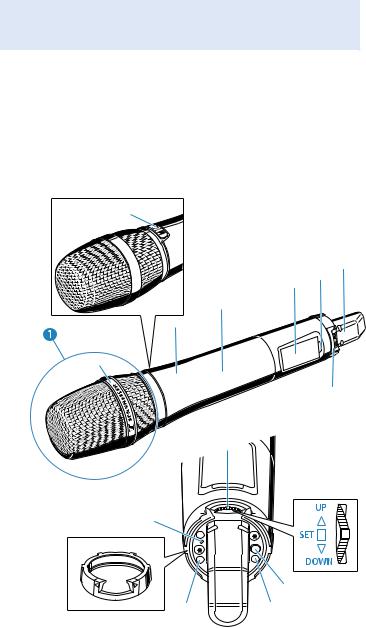
Product overview
Product overview
Overview of the SKM 300 G3 radio microphone



Microphone head (interchangeable)
Name and pick-up pattern of the microphone head (not visible here, see page 4)
MIC button
Body of radio microphone
Battery compartment (not visible from outside)
Display panel, backlit in orange
Infra-red interface
Antenna
Color-coded protection ring; available in different colors
Operation and battery status indicator, red LED (lit = ON/flashing = LOW BATTERY)
Charging contacts
Multi-function switch:
(DOWN), (UP) and  (SET)
(SET)
ON/OFF button
with ESC function (cancel)
6

Product overview
Overview of the displays
After switch-on, the radio microphone displays the standard display “Frequency/Name”. For further illustrations and examples of the different standard displays, refer to page 16.
The display backlighting is automatically reduced after approx. 20 seconds.
|
|
|
531.375MHz |
|
||||||||||
|
|
|
ew300 G3 |
|
|
|
|
|||||||
|
|
|
|
|
|
|||||||||
|
|
|
|
|
|
|||||||||
|
|
|
P |
|
|
|
|
|
|
|
|
|
|
|
MUTE |
|
|
|
|
||||||||||
|
|
|
|
|
|
|
|
|||||||
AF |
|
|
|
|
|
|
||||||||
|
|
|
|
|
|
|
||||||||
|
|
|
|
|
|
|
|
|||||||
|
|
|
|
|
|
|
|
|
|
|
|
|
|
|
Display |
Meaning |
|
|
|
|
|||||||||
|
|
|
|
|
|
|
|
|
|
|
|
|
|
|
Audio level “AF” |
Modulation of the radio micro- |
|||||||||||||
|
|
|
|
phone with peak hold function |
||||||||||
|
|
|
|
|
|
|
|
|
|
|
|
|
|
|
Frequency |
Current transmission frequency |
|||||||||||||
|
|
|
|
|
|
|
|
|
|
|
|
|
|
|
Name |
Freely selectable name of the |
|||||||||||||
|
|
|
|
transmitter |
|
|||||||||
|
|
|
|
|
|
|
|
|
|
|
|
|
|
|
Transmission icon |
RF signal is being transmitted |
|||||||||||||
Lock mode icon |
Lock mode is activated |
|||||||||||||
|
|
|
|
|
|
|
|
|
|
|
|
|
|
|
“P” (pilot tone) |
Pilot tone transmission is |
|||||||||||||
|
|
|
|
activated |
|
|
|
|
||||||
|
|
|
|
|
|
|
|
|
|
|
|
|
|
|
“MUTE” |
Audio signal is muted |
|||||||||||||
Battery status |
Charge status: |
|
||||||||||||
|
|
|
|
|
|
|
|
|
|
|
approx. 100% |
|||
|
|
|
|
|
|
|
|
|
|
|
approx. 70% |
|||
|
|
|
|
|
|
|
|
|
|
|
||||
|
|
|
|
|
|
|
|
|
|
|
approx. 30% |
|||
|
|
|
|
|
|
|
|
|
|
|
||||
|
|
|
|
|
|
|
|
|
|
|
charge status is |
|||
|
|
|
|
|
|
|
|
|
|
|
critical, the red |
|||
|
|
|
|
|
|
|
|
|
|
|
||||
|
|
|
|
|
|
|
|
|
|
|
LOW BATTERY LED |
|||
|
|
|
|
|
|
|
|
|
|
|
is flashing: |
|||
|
|
|
|
|
|
|
|
|
|
|
|
|
|
|
7

Putting the radio microphone into operation
Putting the radio microphone into operation
Inserting the batteries/accupack
For powering the radio microphone, you can either use two 1.5 V AA size batteries or the rechargeable Sennheiser BA 2015 accupack (see “Accessories and spare parts” on page 31).
CAUTION! Danger of damage to the radio microphone!
When unscrewing the radio microphone during operation while pressing the MIC button at the same time, the electronics of the radio microphone will be damaged.
Do not press the MIC button while unscrewing the radio microphone.
Unscrew the lower part of the radio microphone from the radio microphone’s body by turning it counterclockwise.
When unscrewing the radio microphone during operation, the muting function is automatically activated. “MUTE” appears on the display panel.
When screwing the lower part of the radio microphone back to the radio microphone’s body, the muting is canceled. “MUTE” disappears from the display panel.
Slide back the lower part of the radio microphone as far as it will go.
Open the battery compartment cover .
8
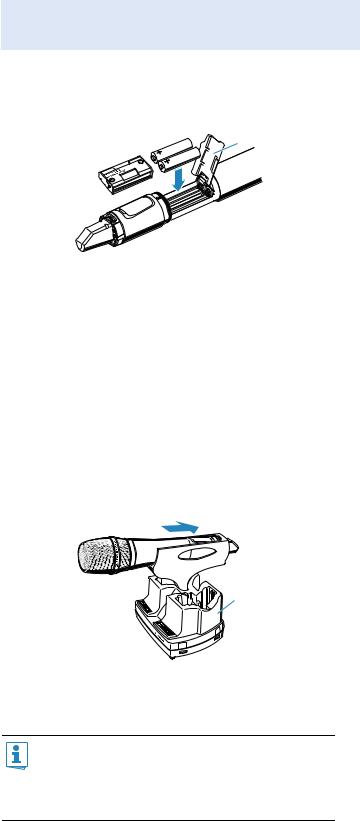
Putting the radio microphone into operation
Insert the batteries or the BA 2015 accupack as shown on the battery compartment cover. Observe correct polarity when inserting the batteries/accupack.
Close the battery compartment cover .
Push the battery compartment into the radio microphone’s body.
Screw the lower part of the radio microphone back to the radio microphone’s body .
Charging the accupack
To charge the radio microphone with the BA 2015 accupack (see “Accessories and spare parts” on page 31) installed:
Insert the radio microphone into the LA 2 charging adapter (see “Accessories and spare parts” on page 31) until it locks into place.
 LA 2
LA 2
L 2015
Plug the LA 2 charging adapter with the inserted radio microphone into the L 2015 charger (see “Accessories and spare parts” on page 31).
The LA 2 charging adapter and L 2015 charger can only charge the radio microphone with the BA 2015 accupack installed. Standard batteries (primary cells) or individual rechargeable battery cells cannot be charged in this way.
9
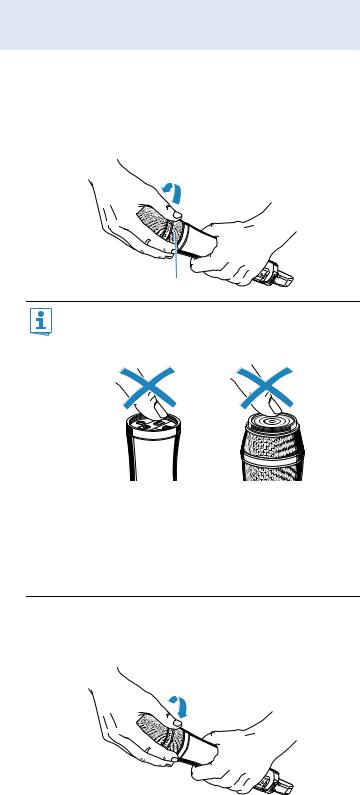
Putting the radio microphone into operation
Changing the microphone head
The microphone head is easy to change.
Unscrew the microphone head .
Do not touch the contacts of the radio microphone nor the contacts of the microphone head . The contacts can become dirty or damaged if touched.
When unscrewing the microphone head during operation, the muting function is automatically activated. “MUTE” appears on the display panel.
When screwing the microphone head back to the radio microphone, the muting is canceled. “MUTE” disappears from the display panel.
Screw the desired microphone head to the radio microphone.
The radio microphone is operational again.
10
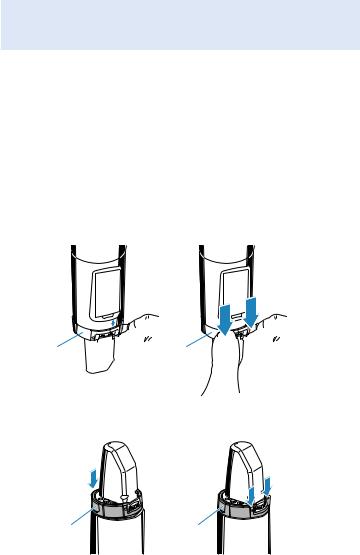
Putting the radio microphone into operation
Changing the color-coded protection ring
The color-coded protection ring prevents the multifunction switch from accidental operation.
Protection rings in different colors are available as accessories (see “Accessories and spare parts” on page 31). The protection rings allow you to clearly identify each radio microphone.
Remove the color-coded protection ring as shown.






Put on a new protection ring as shown.


11
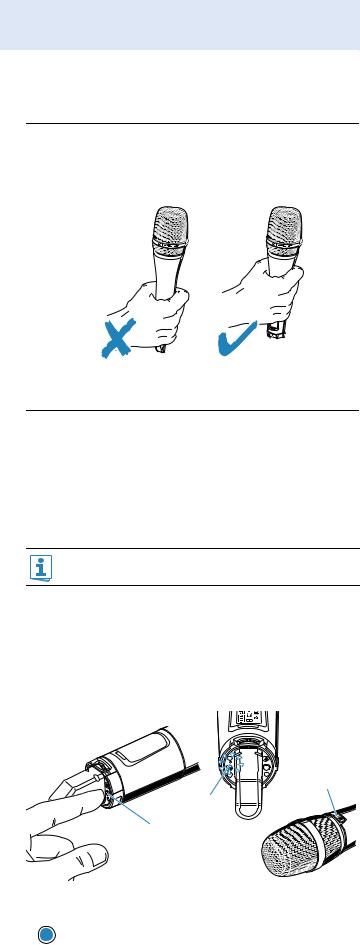
Using the radio microphone
Using the radio microphone
CAUTION! Reduced transmission range
If you touch the antenna of the radio microphone, the transmission range will be considerably reduced!

Only hold the radio microphone by its body.
To establish a transmission link, proceed as follows:
1.Switch the receiver on
(see the instruction manual of the receiver).
2.Switch the radio microphone on (see next section). The transmission link is established and the display backlighting of the receiver changes from red to orange.
It is vital to observe the notes on frequency selection on page 27.
If you cannot establish a transmission link between radio microphone and receiver, refer to the chapter “Synchronizing the radio microphone with a receiver” on page 27.
Switching the radio microphone on/off
To switch the radio microphone on (online operation):
ON/OFF Briefly press the ON/OFF button .
The radio microphone transmits an RF signal. The red ON LED lights up. The standard display “Frequency/Name” appears on the display panel. The MIC button lights up red. The transmission icon is displayed.
12
